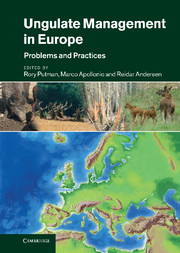Book contents
- Frontmatter
- Contents
- List of contributors
- Scientific names of species referred to in this text
- 1 Introduction
- 2 Status and distribution patterns of European ungulates: genetics, population history and conservation
- 3 A review of the various legal and administrative systems governing management of large herbivores in Europe
- 4 Hunting seasons in relation to biological breeding seasons and the implications for the control or regulation of ungulate populations
- 5 The census and management of populations of ungulates in Europe
- 6 Impacts of wild ungulates on vegetation: costs and benefits
- 7 Wild ungulate diseases and the risk for livestock and public health
- 8 Traffic collisions involving deer and other ungulates in Europe and available measures for mitigation
- 9 Large herbivores as ‘environmental engineers’
- 10 Ungulate–large carnivore relationships in Europe
- 11 The role of pathogens in the population dynamics of European ungulates
- 12 Climate change and implications for the future distribution and management of ungulates in Europe
- 13 Ungulate management in Europe: towards a sustainable future
- Index
- References
1 - Introduction
Published online by Cambridge University Press: 26 April 2011
- Frontmatter
- Contents
- List of contributors
- Scientific names of species referred to in this text
- 1 Introduction
- 2 Status and distribution patterns of European ungulates: genetics, population history and conservation
- 3 A review of the various legal and administrative systems governing management of large herbivores in Europe
- 4 Hunting seasons in relation to biological breeding seasons and the implications for the control or regulation of ungulate populations
- 5 The census and management of populations of ungulates in Europe
- 6 Impacts of wild ungulates on vegetation: costs and benefits
- 7 Wild ungulate diseases and the risk for livestock and public health
- 8 Traffic collisions involving deer and other ungulates in Europe and available measures for mitigation
- 9 Large herbivores as ‘environmental engineers’
- 10 Ungulate–large carnivore relationships in Europe
- 11 The role of pathogens in the population dynamics of European ungulates
- 12 Climate change and implications for the future distribution and management of ungulates in Europe
- 13 Ungulate management in Europe: towards a sustainable future
- Index
- References
Summary
Introduction to this volume
In November 2004, a seminal meeting was held in Erice (Sicily) where representatives from a wide range of European countries were asked to come and offer presentations on ungulate populations and their management in their respective countries. The overall idea was to learn from each others' experiences (and each others' mistakes), in the hopes of developing improved management strategies for the future. Speakers were asked to review the status of populations of wild ungulates in their countries, describe current legislation and management philosophy, and review problems and actual practice with day-to-day management.
The meeting was an enormous success – and very revealing in highlighting the diversity of attitudes and approaches to management of wild ungulates in general, as well as the very different issues faced by wildlife managers in different countries. After the meeting was over the organisers decided to prepare a book to ‘encapsulate’ the material to make it more widely available – to academic researchers, wildlife managers and policy makers alike. At the meeting in Erice, however, presentations covered only some 12 countries from within Europe; and it was determined that the book should be extended in order to include contributions from as many European countries as possible.
- Type
- Chapter
- Information
- Ungulate Management in EuropeProblems and Practices, pp. 1 - 11Publisher: Cambridge University PressPrint publication year: 2011
References
- 3
- Cited by

